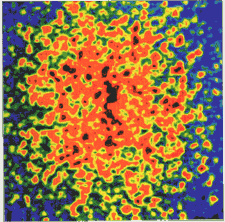X-ray Photon Correlation Spectroscopy Instrument
PURPOSE: The unprecedented brilliance and narrow pulse duration of the LCLS provides a unique opportunity to observe dynamical changes of large groups of atoms in condensed matter systems over a wide range of time scales using X-ray Photon Correlation Spectroscopy (XPCS).
When coherent light or x-radiation scatters from a disordered material, the quasi-random scattering pattern exhibits bright spots, often called “speckles”. The position and intensity of each speckle is sensitive to the exact structure of the material. If the material’s structure evolves in time, the speckle pattern changes. By measuring these changes – correlating the intensity of a speckle with its intensity after a time delay -- the dynamics of the material can be deduced. This is the essence of XPCS.

Typical x-ray speckle pattern, showing the effects of atomic-scale ordering in an iron-aluminum alloy.
Complex dynamics at the nanometer to micrometer scale are ubiquitous at the frontier of research in condensed matter. Viscoelastic flow of liquids, polymer diffusion, crystalline phase transitions and domain switching, and countless other collective processes show both fast and slow equilibrium dynamics, which are often sensitive functions of temperature, applied fields, and fabrication parameters.
As an example of the type of experiment which will be performed at the LCLS, consider the important question of glassy dynamics. Many liquids, when rapidly cooled below their melting points, form a metastable glassy or amorphous phase intermediate between a liquid and a solid. In a typical glass-forming system, the viscosity increases exponentially by many orders of magnitude as the temperature is lowered, until viscous flow processes are effectively frozen. This process involves both fast (picosecond) and slow (nanosecond-microsecond) time scales. The slow time scale is associated with the viscosity, but the nature of the fast time response is still not clear. LCLS can be used for studies spanning a large range of time scales (10-12 to 10-6 s) in order to observe the evolution of the dynamics from liquid to glassy behavior as the temperature is lowered. The short-time end of this range can be simulated in computers. Thus, experiments at these fast time scales would allow direct contact between experiment and computer simulation.
INSTRUMENT CONCEPT: In contrast to the study of stimulated dynamics (pump-probe), the XPCS technique studies equilibrium fluctuations excited by the thermal energy of the sample. Images of the speckle scattering pattern are taken with various time delays between images, and the change in the speckle pattern as a function of time delay is used to study the sample dynamics. Therefore, a key component of this instrument will be a device for generating repeated x-ray pulses with precise time delay adjustable over a wide range. Typically, a single LCLS hard x-ray pulse will be split into two pulses, with the time delay produced by making the pulses take slightly different paths to the sample.

Pulse split and delay scheme for applying the XPCS technique to LCLS. The contrast in the overlapping speckle images gives information about the sample dynamics.
Another important component of this instrument will be the x-ray detector. A large detector with high spatial resolution is required to efficiently collect the speckle pattern.
UNIQUENESS: The technique of Photon Correlation Spectroscopy was first applied to visible light scattering. Using time- or energy-resolved light-scattering techniques, it is currently possible to probe the full range of time scales, from femtoseconds through kiloseconds. However, measurements with visible light are generally not sensitive to the atomic length scales relevant for intermolecular interactions in condensed matter. Third-generation synchrotron sources have provided enough coherent x-ray flux to use XPCS in cases where the dynamics are relatively slow and the scattering power of the sample is relatively large. These measurements are severely limited, however, by the low coherent flux available from even the brightest existing synchrotron source, and from time resolution limitations imposed by the relatively long synchrotron pulse length. The high coherent flux (many orders of magnitude above that available today) and short pulse lengths produced by LCLS will allow the technique to be extended to much more weakly-scattering systems and to much faster time scales.
Inelastic neutron and x-ray scattering techniques are also used to study dynamics at atomic length scales, but they also suffer from low flux and can be used only at the shortest time scales (picoseconds or less). Specialized techniques such as neutron spin-echo and resonant nuclear scattering have their niche, but are not applicable to a wide variety of samples.
Thus the brightness and short pulse properties of LCLS will give this instrument the unique ability to use XPCS to study atomic-scale dynamics over a range of time scales – picoseconds to microseconds – that is inaccessible by any other generally-applicable technique. This time and spatial resolution range is precisely what is needed for studying some problems in condensed matter science that have proved exceedingly complex and intractable, such as the glass phase problem. The XPCS technique at LCLS will also be highly complementary to other techniques for studying dynamics in nano-systems, such as inelastic neutron scattering and stimulated (pump-probe) dynamics measurements taking place using other LCLS instruments.
